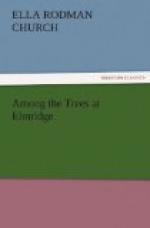“It’s funny-looking,” said Malcolm, when he had made himself thoroughly acquainted with the appearance of the catkin, “but it doesn’t look much like a flower: it looks more like a pussy’s tail.”
“Yes, and that is the origin of its name. ‘Catkin’ is diminutive for ‘cat;’ so this collection of flowers is called ‘catkin,’ or ‘little cat.’”
“I think I’ll call them ‘pussy-tails,’” said Edith.
“There is a great deal to be learned about trees,” said Miss Harson, when all were comfortably seated in the pleasant schoolroom; “and, besides the natural history of their species, some old trees have wonderful stories connected with them, while many in tropical countries are so wonderful in themselves that they do not need stories to make them interesting. The common trees around us will be our subjects at first; for I suppose that you can scarcely tell a willow from a poplar, or a chestnut tree from either, can you?”
“I can tell a chestnut tree,” said Malcolm, confidently.
“When it is not the season for nuts?” asked his governess, smiling.
There was not a very positive reply to this; and Miss Harson continued:
“I do not think that any of us know as much as we ought to know of the trees which we see every day, and of the uses to which many of them are put, to say nothing of many familiar trees that we read about, and even depend upon for some of the necessaries of life.”
“Like the cocoanut tree,” suggested Clara.
“That is not exactly necessary to our comfort, dear,” was the reply, “for people can manage to live without cocoanuts, although in many forms they are very agreeable to the taste, and it is only the inhabitants of the countries where they grow who look upon these trees as necessaries; but we will take them up in their turn. And first let us find out what we can about the willow, because it is the first tree, with us, to become green in the spring, and, of that large class which is called deciduous, the last one to lose its leaves.”
“And why are they called deciduous?” asked Malcolm.
“Because they shed their leaves every autumn and are furnished with a new set in the spring: ‘deciduous’ is Latin for ‘falling off.’ And this is the case with nearly all our native trees and plants. Persistent, or permanent, leaves remain on the stem and branches all through the changes of season, like the leaves of the pine and box, while evergreens look fresh through the entire year and are generally cone-bearing and resinous trees. ’These change their leaves annually, but, the young leaves appearing before the old ones decay, the tree is always green.’”
“Miss Harson,” said Clara, “when people talk about weeping willows, what do they mean? Do the trees really cry? I sometimes read about ’em in stories, and I never knew what they did.”
“They cry dreadfully,” said Malcolm, “when it rains.”




